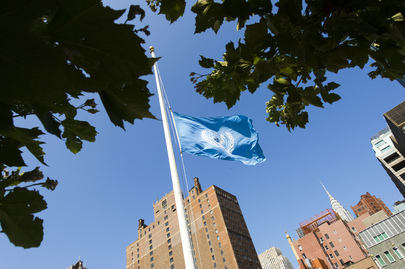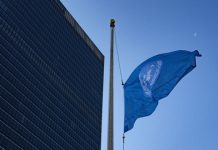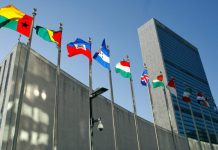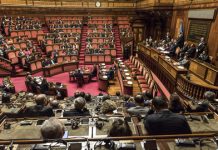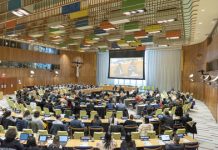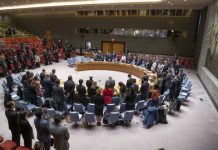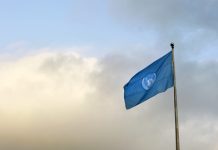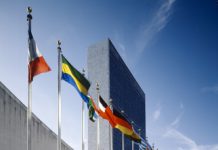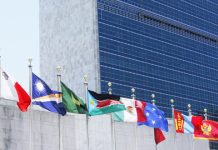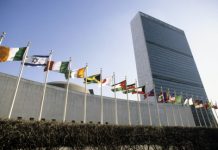This is The Lid Is On, I’m Conor Lennon.
On this episode, we’re going to take you through the outcome of COP29, the UN Climate Conference in Baku, Azerbaijan, which did see an increase in the amount of money committed to climate finance, in other words the money spent on helping developing countries to adapt to the crisis.
Was it enough? And what will mean for the fight against the climate crisis?
And we will also tell you about a new UN-backed initiative, launched right in the middle of COP, to help journalists and the general public to tell the difference between reliable information about the climate crisis, and the torrent of misinformation and conspiracy theories that cont inue to spread around the world via social media.
We recorded the last episode about a week ago, bang in the middle of the conference and, in case you missed it, we heard a chorus of voices calling for a big increase in the amount of climate finance.
My colleague Lara Palmisano spoke to Lisa Doughten, the head of the financing division at the UN’s humanitarian office, OCHA, at the conference, and she painted a stark picture.
Lisa Doughten: In the last 20 years, the humanitarian appeals associated with climate crises have gone up 800%, so it’s been a vast increase in the humanitarian requirements because of the additional climate shocks that we’ve seen. And any rise 1/2 degree rise in the global warming temperatures means that five million additional people may be displaced as a result.
And what we need to do now is find innovative financing applications to ensure that we are looking differently, that we crowd in climate finance. One of the ways that we’re also trying to address is through innovation, is through anticipatory action, which we have been looking at over the last five years, that means. Acting early ahead of when the climate shocks are at their maximum.
Lisa Doughten, Director of the financing and partnership division at the UN Office for the Coordination of Humanitarian Affairs, explaining why a big rise in climate finance is needed.
UNFCCC AND SG REACTION TO SLOW PROGRESS
There was a definite tone of frustration coming out of Baku in week two, with complaints, from many in civil society and the groupings of developing countries in particular, that the figures being floated by rich nations were far from adequate.
There were many African youth activists present throughout the whole conference, and here’s a flavour of that frustration and anger.
AFRICAN ACTIVIST CLIP
The head of UN Climate Change, Simon Stiell, and the big boss, UN Secretary-General António Guterres, weighed in:
SIMON STIELL AND ANTONIO GUTERRES CLIP
Simon Stiell: “We can’t lose sight of the forest because we’re tussling over individual trees. This is a recipe for going literally nowhere. And could set global climate efforts back at a time when we simply must be moving forward.”
SG: “COP29 is now down to the wire. I sense an appetite for agreement, but areas of convergence are coming into focus. But let’s be frank, many substantial differences are still remaining.”
Simon Stiell: “It’s been encouraging to see the significant strides forward, notably on carbon markets, making progress that previous COPs could not achieve. There’s more work to do of course, and I am certainly not complacent, there are still challenges ahead there
SG: “This is a COP to deliver justice in the face of climate catastrophe, to help move us closer to securing a decent world for all humanity.”
Simon Stiell, the head of UN Climate Change, and the UN Secretary-General, António Guterres, speaking earlier in the week .
EXPLANATION OF THE FIGURE, INCLUDING CURRENT NUMBERS
Although negotiators discuss a wide range of issues at every Climate Conference – as well as throughout the year, in smaller meetings- the main aim of this COP was to significantly raise the amount of climate finance doled out each year to help developing countries combat the effects of the crisis – such as an increase in extreme weather events such as flash flooding, drought and wildfires – and support them in their efforts to develop forms of clean energy, such as solar and wind.
Now, 100 billion dollars sounds like a lot of money. And this was the sum that was landed on in 2015, when the nations of the world adopted the Paris Climate Agreement, the basis of climate negotiations ever since.
But that was nearly 10 years ago, and climate experts, along with affected countries, have been insisting that around $1.3 trillion is now needed.
One of the big stumbling blocks has been deciding who pays what.
The list of richer countries on the hook, because of their wealth and historical contribution to the crisis, was drawn up back in 2002. Since then, some countries, notably China and India, have rapidly developed their economies, and raised their emissions in the process. China, for example, is now the world’s biggest emitter of harmful greenhouse gases.
So, the argument posed by some developed nations is that these nations should also pay up.
And then there’s the question of what form this funding takes. Is it in the form of grants, for example, or loans, or investment?
Negotiators have been wrestling with these issues since long before COP29 began.
THE OUTCOME
Well, to no-one’s surprise, the talks over-ran until eventually, very early on Sunday morning, Baku time, a decision was reached.
Here’s what it sounded like, when the COP29 President, Mukhtar Babayev, brought down the gavel, and treated us to some classic UN-style language.
GAVEL CLIP
Mukhtar Babayev: “I hereby invite the CMA to adopt the draft decision contained in the document CMA/2024L .22.”
Part of the agreement involved a deal to move forward the development of a UN-backed global carbon market, to help fund projects that lead to cuts in greenhouse gas emissions. If you remember, that was signed off at the beginning of the conference.
When it comes to the money part of the deal, it was agreed that $300 billion worth of climate finance will go to developing countries every year by 2035, so a threefold increase on where we were before COP29.
When Simon Stiell got up to speak, he focused on the step forward the outcome represents, but didn’t shy away from the disagreements in the room.
Simon Stiell: “It has been a difficult journey, but we have delivered a deal. This new finance goal is an insurance policy for humanity amid worsening climate impacts hitting every country, but like any insurance policy, it only works if premiums are paid in full and on time.”
At COP 28 the world agreed to triple renewables. At COP2 9 we tripled climate finance, and countries will work to mobilize much, much more.”
“No country got everything they wanted, and we leave Baku with a mountain of work to do.”
UN Climate Action chief, Simon Stiell.
And for those of you wondering what happened to the 1.3 trillion dollars per year that developing countries were calling for, well it hasn’t been forgotten.
Yes, the developed world did not agree to stump up that much per year but, included within the agreement, was a pledge to “Secure efforts of all actors to work together to scale up finance to developing countries, from public and private sources, to the amount of USD 1.3 trillion per year by 2035.”
If you head to our website, UN News, you will find a comprehensive breakdown of the deal from our teams in Baku and New York, including a statement from António Guterres, and the very mixed reactions from different parts of the world, from the EU, which expressed confidence that the money on the table would enable the $1.3 trillion goal to be reached, to India, which called the new goal “a paltry sum that does not inspire trust.”
UN REACTION
Our UN team were on tenterhooks over the final days, as talks overran, to no-one’s surprise.
Martina Donlon, from the UN’s Climate Action Team, was up into the small hours, and she sent me her reflections as she was making her way back to New York.
MARTINA CLIP
This will go down in history as one of the longest COPs ever stretching into the early Sunday morning hours, more than 35 hours beyond the scheduled closing time.
Gone were the friendly volunteers directing participants throughout the venue, booths and exhibits had been taken down, and sandwich and coffee shops were empty and closed.
The only ones remaining until the bitter end, along with the delegates and observers, were the demonstrators holding big signs saying “pay up”, and they were understandably disappointed with the outcome, as were many developing countries.
But we did reach a deal that will move us forward incrementally, bit by bit, into the right direction.
The outcome document does call on all actors to work together and scale up finance further to actually reach the $1.3 trillion a year that is needed.
However, much of that will have to come from private sources of funding and from new sources such as levies and taxes on fossil fuels. and that’s not what developing countries were asking for.
What they need is a lot more public funding and only 300 billion of that was agreed in this outcome.
Martina Donlon, from the UN Climate Action Team, looking forward to a good night’s sleep.
INFORMATION INTEGRITY
Before we go,
Remember climate deniers? These were the people and organizations who insisted that the man-made climate crisis doesn’t even exist.
These days, as the weight of evidence to the contrary has grown, we hear less outright climate denial, but there are still plenty of conspiracy theories, misinformation and downright lies being spread, hampering the important work that is being done to address the issue, and even putting lives at risk.
The Global Initiative for Information Integrity on Climate Change, a joint campaign by Brazil and the UN, during the G20 meeting of major economies in Rio de Janeiro, aims to strengthen research and measures to address all disinformation which has the effect of delaying or derailing climate action.
Earlier in the week, I spoke to Guilherme Canela, chief of the Freedom of Expression and Safety of Journalists Section at UNESCO, the UN education, science and culture agency. He explained the aims of the initiative.
GUILHERME CLIP INFO INTEGRITY
GC: Climate change in a way or another, is affecting our lives. And since it’s affecting our lives, we need to take decisions about it. We need to know what to do. We need to know which policies to implement or how to proceed with our lives. In face of this huge challenge. And for that, we need evidence. We need concrete information we need reliable information to take these decisions.
So, at the core of this initiative, this is what we want. We want to make sure we understand how information is impacting the discussion about climate change positively. If this information is accurate and reliable and unfortunately negatively, if this is about disinformation or misinformation. So, in a nutshell, this initiative will stimulate the knowledge production about what’s going on in the information space, the information ecosystem about climate change.
CL: So when it comes to conspiracy theories, downright lies, how bad are things right now when it comes to information that’s out there in that ecosphere, as you say online?
GC: So the the available elements we have is that it’s bad that there there is a lot of conspiracy theories as you said there is a lot of disinformation, falsehoods about climate change, about what is already consolidated scientific knowledge produced by scientists all over the world, but the other side of this story is that unfortunately we don’t have in depth research, particularly coming from the global majority or the global.
south detailing what is the logic of this disinformation that is out there? What is the characteristics of these conspiracy theories? Who is funding this? How this is being operating in different languages in different countries in different contexts?
So, this initiative is really about going deeper in understanding this phenomenon. The phenomena of this information, the phenomena of eventually conspiracy theories that are impacting the decisions we all take, including decision makers, therefore production of policies to address this huge risk for our societies that are climate change.
CL: OK, so you want to find out how it’s happening, why it’s happening? Could we be doing better, though? I mean, us at the United Nations, generally, broadcast journalists. Could we be doing more to be pushing the verifiable information? The truth in other words.
GC: Oh sure. I mean I think there are three key elements here. First we need to qualify the demand for reliable and accurate information and this is about education. It’s about empowering every citizen to have a more critical relationship with the digital ecosystem, empowering every citizen to understand when to not forward the message that the person received and it looks like this information etc.
But this qualification of the demand, this empowering of the citizens, it’s a is a necessary, but it’s not a sufficient condition because you also need to do the other side. You need to empower the supply side of reliable and accurate information.
And for that we need to support we need to support independent journalists, we need to support scientists, we need to support artists, we need to support content producers that are including in the ecosystem and reliable and accurate information, and the UN overall, including UNESCO and others.
We could do, we are already doing a lot, but we could do much more with these two elements, the demand and the supply. But this initiative is about a third element that is the transmission chain, is about the ecosystem itself. So how we understand that this information navigating in the digital sphere, in the digital ecosystem, and if we can understand better how this is navigated and as you said, who does it in which which, which purposes and how this is amplified then several actors but including the UN, we will be in a better position to build policies and actions to counter this disinformation regarding climate change, and therefore, on the positive side, improving the information integrity about climate change.
That was Guilhelme Canela from UNESCO, on the launch of a new UN-backed initiative to help ensure that we can access the truth about the climate crisis, and avoid conspiracy theories and disinformation.
NEXT STEPS/ BRAZIL
The next important step, in terms of climate finance (as far as the UN process is concerned at any rate) comes in June, at the fourth international conference on financing for development, which is being held in Seville, Spain.
As the name suggests, climate will not be the only item on the agenda, but will definitely be in the mix, as delegates look for a formula for financing the Sustainable Development Goals ahead of the 2030 deadline.
And then, in less than a year from now, the next COP will roll around, and it will take place in Belem, in the Brazilian rainforest.
It is being billed as one of the big ones, because it will tackle a core element in the fight against the climate crisis: cutting greenhouse gas emissions.
All the nations of the world will be expected to turn up and talk about how they are going to put in practice their plans to reduce their reliance on fossil fuels and power their economies on clean, renewables energy sources.
OUTRO
If you want to dig in further, UN News has several stories on all of the big issues at COP29, and we even have a “climate and environment” tab where you can learn much more about what is actually going on in this space. Links in the show notes.
That’s all for this episode of The Lid Is On, thanks for listening.
Source of original article: United Nations (news.un.org). Photo credit: UN. The content of this article does not necessarily reflect the views or opinion of Global Diaspora News (www.globaldiasporanews.com).
To submit your press release: (https://www.globaldiasporanews.com/pr).
To advertise on Global Diaspora News: (www.globaldiasporanews.com/ads).
Sign up to Global Diaspora News newsletter (https://www.globaldiasporanews.com/newsletter/) to start receiving updates and opportunities directly in your email inbox for free.


